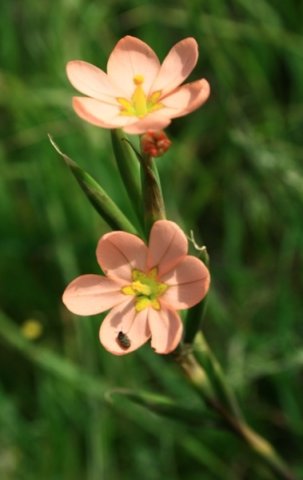Moraea miniata

Moraea miniata, previously Homeria miniata, is a perennial geophyte of the Iridaceae family bearing salmon, yellow or white flowers. The flower has a star-shaped yellow patch in the centre covered in fine speckles. This central star is delineated here by angular lines at the base of the six tepals. A faint dark line runs centrally along the length of each tepal. There are a few trailing narrow leaves from the base and a corm covered in a fibrous tunic below ground.
The plant grows in renosterveld and scrub in clayey soil from the Richtersveld to Bredasdorp, as well as in the Karoo. The species is not considered to be threatened in its habitat early in the twenty first century.
It is poisonous, holding danger to livestock: one of the notorious tulpe spelling trouble for stock farmers. The plant is banned in Australia for invading.
South Africa and Australia are suffering from quite a few of these "undiplomatic" botanical exchanges. Both countries battle unwanted aliens, invader plants proliferating on farms and in the natural vegetation. The long-term implications are often recognised too late, the danger not imagined of a species so attractive and innocuous on its home ground.
Adhering to the rules that apply for preventing further accidents of this nature are in everyones interest: Dont take biological material over national borders in contravention of the law (Manning, 2009; http://redlist.sanbi.org).

